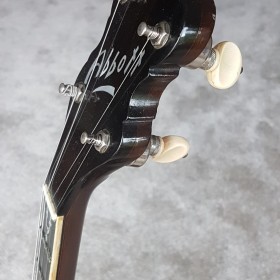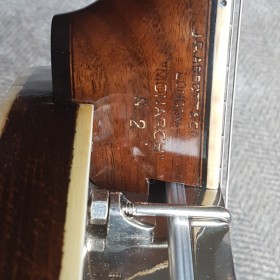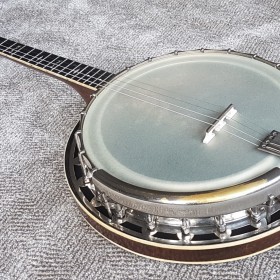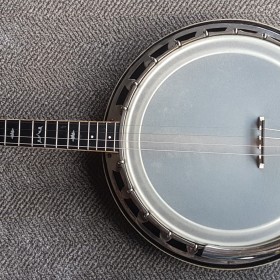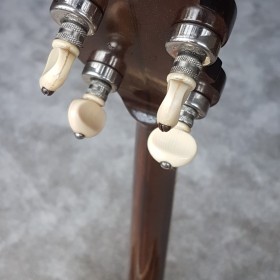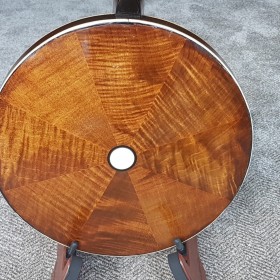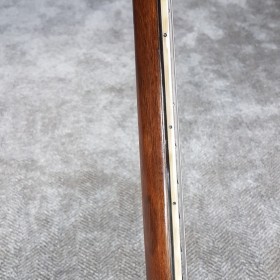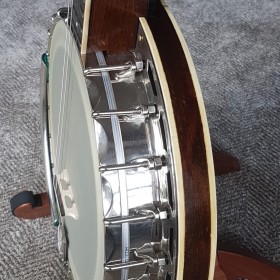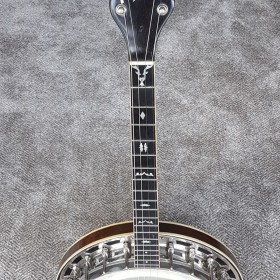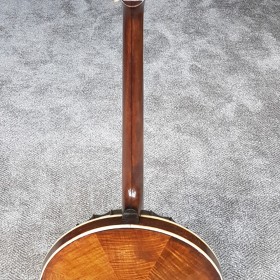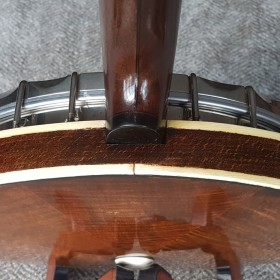Abbott Monarch Tenor Banjo
|
1930’s Abbott Monarch N0.2 19 fret tenor banjo made in London. A very well made tenor banjo in select dark stained maple and quality nickel plated metal construction. JG Abbott made fine banjos and in the mid 20’s early thirties he would have purchased his hardware direct from Clifford Essex, the company which made the high end Paragon models. They have the same scalloped hoops and similar tonerings. This 19 fret model is in great condition and has recently been set up for Irish Trad playing, with low action. 3 piece maple neck with original Grover pancake tuners, ebony fret board with mother of pearl floral position markers and good frets. The neck also has white & ebony binding with side position dots. The pot is metal which is attached to the flange and a new Remo renaissance head is held in place with the scalloped tension hoop. Kershner tailpiece and wide arm rest, the resonator pie crust sections are beautifully dark stained maple. This is a great sounding, great condition, tenor banjo looking for a new home. Comes with vintage case
SOLD
A little bit of history
John George Abbott was born in 1877 in Poplar, London and was a cabinet maker by trade. By the end of the century. I can imagine the musicians who were ‘getting into’ banjos around the turn of the century, looking for skilled craftsmen to make instruments. Fortunately, they found John Abbott.
In 1901 he went to supervise the production of Barnes & Mullins banjos at their factory in Harrow.
When he left in 1905, he started his own company J G Abbott & Co in Hampstead Road , London. He made banjos under his own name and for several of the other ‘names’ in the banjo business such as Norton Greenop, Charles Skinner, John Alvey Turner and Len Shevill. It is not uncommon to find an Abbott-made banjo of this era branded by another firm , such as Hawkes.
There were two main makes of banjo – an ordinary Abbott banjo in 3 grades with grade 1 being the best and a more expensive banjo named either the Monarch or the Mirabile depending on the type which was also graded by decoration and quality.
1905 was also the year that his son was born. He was also called John George, just as his father and grandfather had been – there were three generations of John George Abbott living at this point in time.
As John junior, or Jack as he became known to distinguish him from his father, grew up, he learnt the trade of instrument making and for a period of time in the late 1920s and during the 1930s both men worked together producing guitars, banjos and banjo ukuleles at their workshop in London which had moved in 1928 to Chalton Street. During this era, it is possible to confuse the attribution of a particular Abbott instrument but those in the trade can spot the tell-tale differences in workmanship between father and son.
When JG Abbott grew ill in 1936 and gave up the business, Jack started on his own producing guitars, occasional banjos and banjo ukuleles. Around this time, Besson’s acquired J G Abbott & Co.
JG Abbott, John senior, died in 1938.
Jack continued making instruments until the mid 1950s when he retired and returned to the stock exchange which suggests that he initially trained for and worked there before becoming an instrument maker. He also moved out of London to Cambridgeshire where he was persuaded out of retirement in 1970 to make around 200 banjo ukuleles for the George Formby Society over the next 8 years.
Jack died in February 1994.
